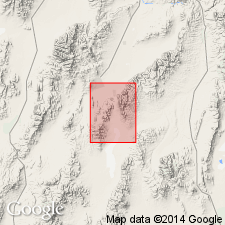
- Usage in publication:
-
- Fourmile Canyon Formation*
- Modifications:
-
- Named
- Biostratigraphic dating
- Mapped
- Dominant lithology:
-
- Chert
- Siltstone
- Argillite
- Shale
- Sandstone
- AAPG geologic province:
-
- Great Basin province
Summary:
Pg. 12, 54-57, pI. 1 (geol. map), pl. 2 (fossil locs.). Fourmile Canyon Formation. Present in northeastern part of Cortez 15-min quadrangle, Eureka County, Nevada, in upper plate of Roberts thrust (western facies). Principally chert, siltstone, argillite, and shale, and a few thin beds of fine-grained sandstone. On fresh fracture nearly all rocks are very dark gray. Lack of marker beds and irregularity of the attitudes of formation throughout area of outcrop preclude accurate measurement of thickness. Thickness may be 4,000 to 6,000 feet. Both upper and lower contacts are mechanical. Rocks make up thrust slice that rests directly on Roberts thrust along east wall of Mill Canyon and is overridden at north by higher slice of Valmy Formation and at south by one of the Vinini. Age is considered Early Silurian, based on fossils (graptolites). Report includes geologic map.
Type locality not stated. Exposed on both sides of Fourmile Canyon, near northeast corner of Cortez 15-min quadrangle, Eureka Co., north-central NV. Crops out over area of nearly 10 sq mi in drainage areas of Fourmile and Mill Canyons, and in unnamed stream northeast of Fourmile Canyon.
Source: Publication; US geologic names lexicon (USGS Bull. 1350, p. 271).
For more information, please contact Nancy Stamm, Geologic Names Committee Secretary.
Asterisk (*) indicates published by U.S. Geological Survey authors.
"No current usage" (†) implies that a name has been abandoned or has fallen into disuse. Former usage and, if known, replacement name given in parentheses ( ).
Slash (/) indicates name conflicts with nomenclatural guidelines (CSN, 1933; ACSN, 1961, 1970; NACSN, 1983, 2005, 2021). May be explained within brackets ([ ]).

